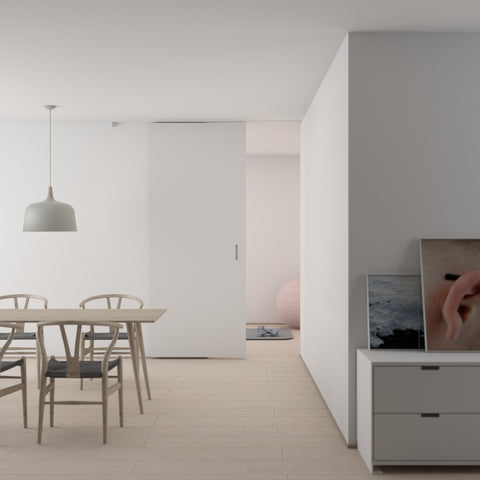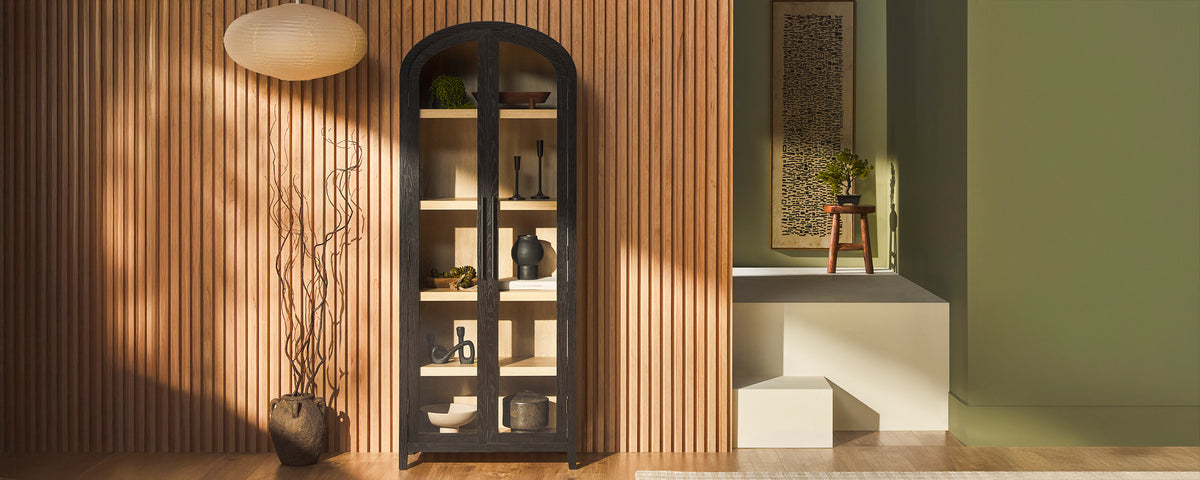Japandi Style Guide
Japandi, a portmanteau of Japanese and Scandi (Scandinavian), is a blend of the two regions’ interior design styles that has recently risen in popularity. Japandi fulfills a shift toward eco-conscious design, and its serene, natural, and clean aesthetic gives us respite from our increasingly stressful lives. Let’s see how two styles from opposite sides of the world combined to create something unique.
Traditional Japanese Design History
To better understand each half of Japandi, let’s first look at the influences on traditional Japanese interior design. It has ancient roots, becoming more intentional between the 8th and 12th centuries. Centuries-old traditions and philosophies inform all aspects of Japanese culture, begetting a natural minimalist interior style. Shinto beliefs instill a respect for nature; Zen emphasizes self-restraint, harmony, and simplicity; ma is a pause or negative space where growth and possibility reside; and wabi-sabi is to make peace with imperfection and the impermanence of all things.

Scandinavian Design History
Scandinavian style is a product of its geography. To combat long winters with short daylight hours and cold temperatures, designers began to favor bright, neutral color palettes, large windows, and cozy lighting. Lush green plants were often incorporated to breathe life into the stark environment. Smaller Nordic homes inclined designers toward open floorplans, multipurpose spaces, and clutter-free decorating. The style really coalesced in 1914 after a push to promote the region’s local craftsmanship and practical furniture design.

Merge
The term “Japandi” is relatively new, but ancient Japanese traditions and comfortable Scandinavian sensibilities began to merge in the 1850s when Japan opened its borders to the West. After 200 years of isolationism, a cultural exchange bloomed as Japanese people were allowed to travel abroad and international people were allowed to visit Japan.
After World War II, limited resources shifted both Japan and Scandinavia toward simplified, practical, and attainable designs. As our modern world grows increasingly hectic, a more deliberate combination of the two peaceful styles has occurred, formally creating Japandi.
Vetti Faux Shagreen Desk – Walker Edison Faux
Leather Dining Chair – Walker Edison
Shared Features
In order to understand how Japandi is unique, we must first look at what Japanese and Scandinavian styles have in common. The origins and motivations of these similarities may draw from different sources, but their carryover to Japandi is a natural progression.
- Organic touches like unfinished natural wood, ceramic, stone, and indoor plants. If Japanese design is a celebration of nature, Scandinavian design is an adaptation to nature, with both exhibiting a deep appreciation for it.
- Floorplans are open, adaptable, and multipurpose. Scandinavian designers originally favored open spaces to make their small interiors feel airier. Meanwhile, traditional Japanese interiors often feature fusama or shouji panels (movable wall pieces) that can be added or removed to change a space’s size and function.
- Clutter and excess are kept to a minimum, but the aim is not deprivation. Items are put away when they’re not in use and you keep what you need to live comfortably, nothing more and nothing less. We see this reflected in Sweden’s “just enough” concept of lagom, or the Japanese KonMari Method of keeping only what sparks joy.
- Quality over quantity. Japan’s deep respect for tradition and both countries’ enthusiasm for fine craftsmanship encourages decorators to choose a few high-quality pieces as opposed to lots of temporary ones. Limited post-world-war resources and the recent trend toward eco-conscious design further emphasize this.
- Decorative focal points. To avoid overstimulation and clutter, both styles dedicate a few specific spots for striking decor. This is often expressed as large art pieces and pops of color.
- Minimal ornamentation, particularly on furniture. Clean lines are prioritized for being neat and unobtrusive. Meanwhile, intricacy is often derived from a piece’s structure and function, making any useful piece inherently beautiful.
- Artificial lighting is generally warm, low, and diffused for an ambient glow that is gentle on the senses.
Kacie Modern Sideboard – Walker Edison
Borrowed Features
Japanese and Scandinavian design share so many characteristics that a team-up feels natural, so how is Japandi unique from either of them? The aesthetic finds its independence in what it borrows from each and combines under one roof. It is this blend that sets Japandi apart from its parent styles.
From Scandi design:
- Bright, neutral tones like white, light grey, and light woods. Neutrals are the crux of both styles, but Scandinavian palettes are lighter and cooler, keeping Japandi bright and fresh.
- Soft, plush textures that soften and warm the surroundings. Chunky woven blankets, fur throws, and leather furniture are common inclusions.
- Windows are large and left untreated. While Japanese design is no stranger to natural light, letting in as much sunlight as possible is uniquely Nordic.
- Decorators seek the Danish ideal of hygge, which encourages us to curate relaxing environments in the pursuit of comfort and clarity.
Faux Leather Counter Stools - Walker Edison
From Japanese design:
- Deep, earthy neutrals like brown, olive green, or warm tan. These colors balance Scandinavian’s stark brightness with a grounding richness.
- Japan-specific natural elements like rice paper lamps, bamboo, and bonsai trees.
- Low furniture profiles. Japanese culture honors a longstanding tradition of eating and socializing on the floor. Japandi style usually opts for seating that is a little raised up off the floor, but most furniture still maintains a very low profile.
- The philosophy of wabi-sabi encourages decorators to find peace in imperfection and the effects of time. Beauty is derived from functionality, and pieces becomes more beautiful with time and use, so Japandi is glad to incorporate pieces that are asymmetrical, rustic, and weathered.
Spindle Back Solid Wood Queen Bed – Walker Edison
Mid-Century 1 Drawer Solid Wood Nightstand – Walker Edison
The result of Japandi is an inviting, natural, warm, and practical minimalism that is greater than the sum of its parts. We can think of Japandi as Japanese style with an extra dash of refreshing coziness, or Scandinavian style deepened by rich earth tones and welcomed imperfection. As a style that is so deeply rooted in quality, tradition, and peace, Japandi will be easing our minds for generations.


